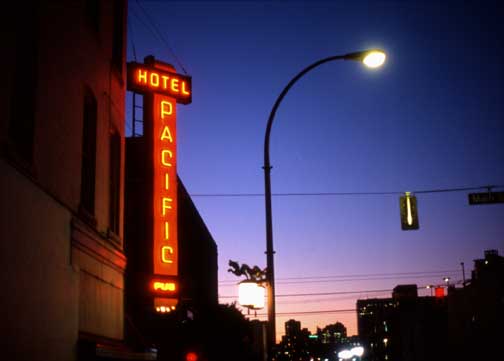 Pacific
Hotel Pacific
Hotel
208
East Georgia Street, Vancouver, British Columbia
Other
Name:
London
Hotel
Statement
of Significance
Description
of Historic Place
The
historic place consists of a plain three to four-storey brick
hotel and pub located at the 208 East Georgia Street, on the fringe
of Vancouver's historic Chinatown. Formerly known as the London
Hotel, the facility is currently called the Pacific Hotel. A pub
on the ground-floor level is entered through double doors set
in the canted corner.
Heritage
Value
Constructed
in two stages between 1903 and 1910, during Vancouver's pre-World
War I building boom, the London Hotel's heritage significance
is derived from the representative character of both its use and
its architecture.
The historic place consists of two parts: a three-storey section,
likely built in 1903, occupying the corner, with eight closely-spaced
windows facing Main Street and seven more widely-spaced windows
on East Georgia Street (as well as the canted corner); and a four-storey
section, built in 1910, with four windows facing East Georgia
Street. A bar and restaurant were located on the ground floor
and the upper floors of both sections were used for residential
accommodation. Daniel McPhalen, who owned the building, acted
as his own contractor. McPhalen, who arrived in the City in 1886,
had a long history as a contractor in Vancouver.
The building demonstrates a pattern of use that was common in
this part of downtown Vancouver, where the service, retail, and
residential industries were geared to serving the itinerant population
of male resource workers. Especially in the winter, when the logging
camps were shut down, men lounged on the street and passed their
time in the bars. The restaurant and bar in the building likely
catered to men recently returned from the bush, which would have
been particularly convenient with the subsequent opening of the
nearby Canadian Northern Railway station (1917-19). This contributes
to our understanding of working-class male history in Vancouver.
Of particular interest here is the endurance of the facade of
the bar, modified at ground level, with its blanked out windows
and solid doors. From the 1920s to the 1970s, provincial laws
carefully regulated the consumption of beer and liquor. This reflected
social attitudes which abhorred drunkenness and condemned the
social ills, such as prostitution and gambling, perceived to be
associated with alcohol. Social reformers preferred total prohibition,
but when this failed, they demanded that drinking establishments
be hidden from public view, that no food or entertainment be povided
to entice men to drink more, and that nothing harder than beer
be served. In Vancouver, men and women were segregated, with a
separate area set aside for 'ladies and escorts.' A 'ladies beer
parlour' was constructed at the London Hotel in 1931. The two
entrances remain, one at the corner and one along Main Street.

Architecturally, the building has value for demonstrating the
progress of commercial architectural design in Vancouver, marking
the transition from the segmental-headed windows popular around
1900 (and seen in the corner portion) to the flat lintels introduced
by 1910 (and seen in the four-storey portion and also on the southern
portion of the Main Street elevation). The more elaborate articulation
of the windows at the corner emphasizes the entrance. For many
years, there was a vertical sign suspended above this corner entry.
A classical dentilled cornice unites the composition. The external
fire escapes and internal light wells are typical of hotels built
at this time in Vancouver. The historic place contributes to the
continuity of the streetscape, as it is part of a series of similarly
scaled buildings.
Source: City of Vancouver Heritage Conservation
Program
Character-Defining
Elements
The
character-defining elements of the London Hotel include:
 -
Location, at the edge of Chinatown, near the train station -
Location, at the edge of Chinatown, near the train station
- Location at a corner, with the principal entrance set into a
canted corner bay
- Scale of the building, which is compatible with its neighbours
- Articulation of window openings, including spacing, variations
in head detail and emphasis with raised or inset brick panels
and stone sills
- The classical cornice with dentils
- The alterations to the ground floor, which although unattractive,
with its small tinted windows and solid doors, is representative
of the Vancouver 'beer parlour'
- Window and door joinery, including the double-hung sash, panelled
doors, vestiges of the original pub shopfront, and awning boxes
- The ongoing use as a hotel, including upper floors for single-room-occupancy
accommodation and the ground floor bar
- Elements that reveal the residential use, such as the external
fire escapes and internal light wells

http://www.historicplaces.ca/
|